SECRET BERRIES, CHERRIES FOR ALL, & WEEDS
Shad, Service, June: All The Same Berry
I’m not saying where my juneberries — now ripe — are, except to say that they are not here on my farmden. If you don’t know juneberries (Amelanchier spp.), you’ll wish you did. Imagine, if you will, a blueberry look-alike with the sweetness and richness of a sweet cherry along with a hint of almond. The plant is also known as shadbush, shadblow, serviceberry, and, in the case of one of the species, saskatoon.
I’ve planted and grown juneberries, but no longer do so. In the 15 years during which I had 6 plants, I harvested only a handful of berries. Juneberries, although look-alikes for blueberries, are pome fruits, related to apple and sharing many of the same pest problems. Here, apple has many problems, including plum curculio, apple maggot, cedar-apple rust, and black rot.
But other sites are more friendly to apple and especially to juneberry. Juneberry is commonly planted as an ornamental; I’ve seen it doing well with the sun beating down on a strip of soil between a vertical wall of concrete and a concrete sidewalk near the entrance to a shopping mall, with passing shoppers unaware of the tasty berries dangling from the branches. (“My” secret juneberries are closer than the nearest shopping mall. Here’s a hint: Mine are within 4 miles of my farmden.)
Juneberry is also a native plant (in every state, in fact) that, in good years, is laden with fruit. Except, as I said, here on my farmden. It’s well worth planting on the chance that it will thrive. I should have given up on mine sooner.
As an ornamental, juneberry is valued for it’s neat form in winter, that of a shrub or a small tree, for it’s white or pink blossoms, and, with a variety such as Autumn Blaze, for the crimson color its leaves turn in fall.
It would be nice to be able to just wander out my back door to pick juneberries, but I won’t complain. A 4-mile bike ride on an early summer morning isn’t too much to pay for the berries.
Nanking, The Easiest Cherry of All
Right now, I can walk out my FRONT door to enjoy another now-ripe, uncommon fruit. Years ago, I had planted forsythia along my driveway. The yellow blossoms fairly glowed with heat in April, but after that the row of bushes was just a blob of greenery. Not unattractive, but not necessarily attractive either.
I ripped out the forsythia and planted instead a row of Nanking cherries (Prunus tomentosa), a species of cherry from Manchuria that first made it to American shores — to great enthusiasm — at the end of the 18th century. Gardeners were not sure whether to praise it more highly as an ornamental or as a fruiting plants. When my plants are awash in white blossoms, bicyclists have stopped and asked for the identity of the plants.
Nanking cherry blossoms at about the same time as forsythia but does not subsequently recede into obscurity. Right now the greenery is punctuated by bright red cherries, their small (1/2 inch or slightly larger) size offset by their abundance. Enough to almost hide the branches. Enough so that birds can eat them, chipmunks can eat them, my ducks can eat them, and still there’s more than enough for us humans. The flavor varies from bush to bush, but they’re all good, tasting somewhere on the spectrum between sweet and tart cherry.
In contrast to juneberry, which once joined Nanking cherry in that row along the driveway, Nanking cherries have no significant pest problems. Sometimes branches die back a little but overall production is rarely impacted. In its native haunts, the plants tolerate winter lows of minus 50 degrees F. and summer temperatures soaring to 110 degrees F.
Mostly I just graze the fruits as I walk up or down my driveway. Last year I harvested enough at once to juice by squeezing them through a strainer. Straight up, one of the most refreshing and delicious juices I’ve ever had.
Pretty Weeds, But They’ve Got to Go
Warm temperatures and abundant rainfall are giving weeds a heyday. The row of Nanking cherries has become home to two prominent weeds, both ornamental in their own right, but not enough to justify their crowded presence.
Japanese knotweed (Fallopia japonica), sometimes called Mexican bamboo, has migrated from a solid stand across the road to the foot of the hedge. The arching stems, heart-shaped leaves, and foaming white flowers, the latter due at the end of summer, explain why the plant was introduced from Asia in the late 1800’s.
The plants are either male or female, and female plants rarely set seed, making me wonder how the plant got across the street.
The other weed, bindweed (Convulvulus arvensis), would be as welcome as its well-behaved cousin, morning glory, if, like morning glory, it was an annual, or at least a well-behaved perennial. The flowers look like pale morning glories. Beneath the ground is where bindweed shows its dark side. The perennial roots spread far far and wide, sending up new shoots likewise far and wide from the mother plant, and the plant seeds abundantly.
Repeatedly cutting back or pulling either weed should eventually starve the roots of either plant, if not eliminating them at least keeping then from smothering the Nanking cherry bushes. That’s pretty much all the care the Nanking cherry hedge needs beyond some pruning every few years to encourage some young growth and keep the shrubs from growing too large.

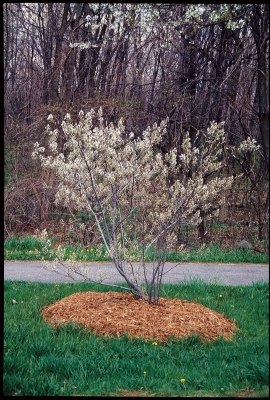
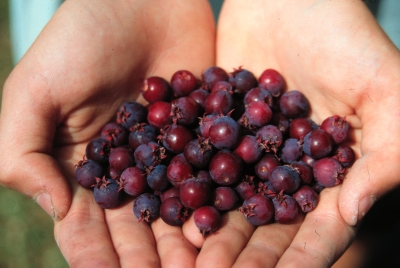
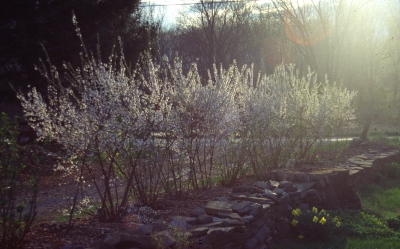
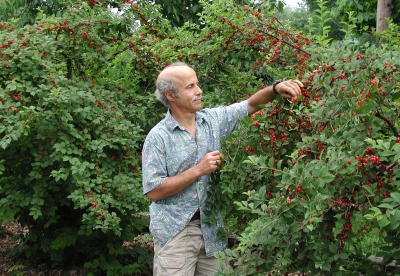
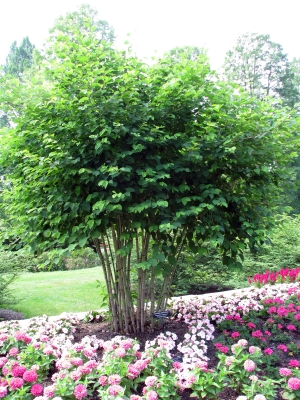
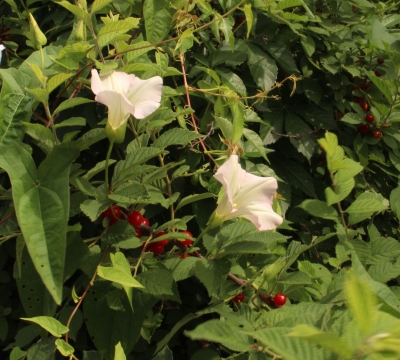


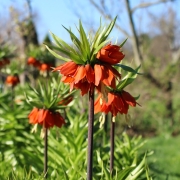
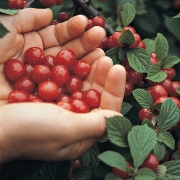
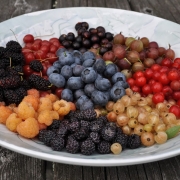

Yum! I have a young Serviceberry (Juneberry) and I usually leave the berries for the birds but you’ve convinced me to try them! My variety is Amelanchier Laevis which I believe is still edible? It has taken a few years to settle into my garden but now it seems as if it will flourish. I also have bindweed without the benefit of cherries! I have a b*tch of time keeping that weed under control. It is monstrous. Thankful not to have knotweed, too, although it is in this area – I think it is in every area.
A. laevis is delicious. Do try it.
I noticed this morning that I have some fire blight on my autumn brilliance here in my northern tn garden. Besides cutting out the affected stems, is there anything natural I can do to treat the tree? Will the fb continue to worsen? I don’t like to use fungicides. We have had nothing but rain this summer but the tree has good air movement and drainage. I just planted it last fall.
Thanks
I suggest pruning diligently, cutting away blighted stems 6 inches into healthy wood as soon as noticed, and then burning or burying prunings. Keep at it through the summer, and sterilize shears between cuts to avoid spreading the disease with your tool.
can you expand a bit why your site is not good for june berries or apples but a site only 4 miles away is?
Colder, moister air here, and close proximity to 6,000 acres of forest.
So… if you owned say 50 acres of the closest forest… is there anything that you could do to fix the problems of being too close to a forest?
Cut down some trees? Hope for the best.
It would be great if you wrote a piece on how to shop for land if you want to grow apples
Northeast facing slope ideal, but any slope would be good, with planting halfway up it. Well drained, moderately fertile. Full sun.
In fact, ALL the plants you’ve named sound good. I’ve tried Honeyberries, tree service, and Elderberries before and they were fantastic. I can’t wait to taste these other berries described in this article. The berries are also cooked in pies and other foods. The tree is drought-resistant so it makes it a good choice to a place near homes and driveways in hot, dry climates. Like most plants, berries can cause health problems for people who have certain allergies. Some people are allergic to leaves or sap. They can also be toxic for children, so parents should always check new plants and berries with their pediatrician.
I’m really glad I found your blog! It’s been really helpful for me to find information on Juneberries. I’ve never seen them in the grocery store where I live, but now that you mentioned they’re native plants (in every state) then maybe there are some around here too!
Yes, every state. Somewhere.
I never tried eating those blueberries yet since I was raised in Asia. They’re available at the supermarket but they’re frozen, and not fresh anymore. We eat them in can. Wondering how these fresh berries taste like !
You must mean blue berries, not blueberries. The berries I wrote about for that post are juneberries, which look very much like blueberries but are a totally different fruit botanically and in flavor. Supermarkets offer fresh and frozen blueberries but pretty much never juneberries. But they’re all delicious and worth growing.
Thanks for the informative post on berries! I was wondering if you’ve ever tried juneberries? They’re a delicious blueberry look-alike with the sweetness and richness of a sweet cherry along with a hint of almond.tree pruning
I have tried juneberries. They are delicious. Your description of the flavor is exactly the way I’ve described it. Unfortunately, they don’t do well in my yard. (For a few reasons, my site is generally poor for fruit growing.) But they do do well a few miles from here.